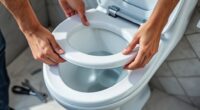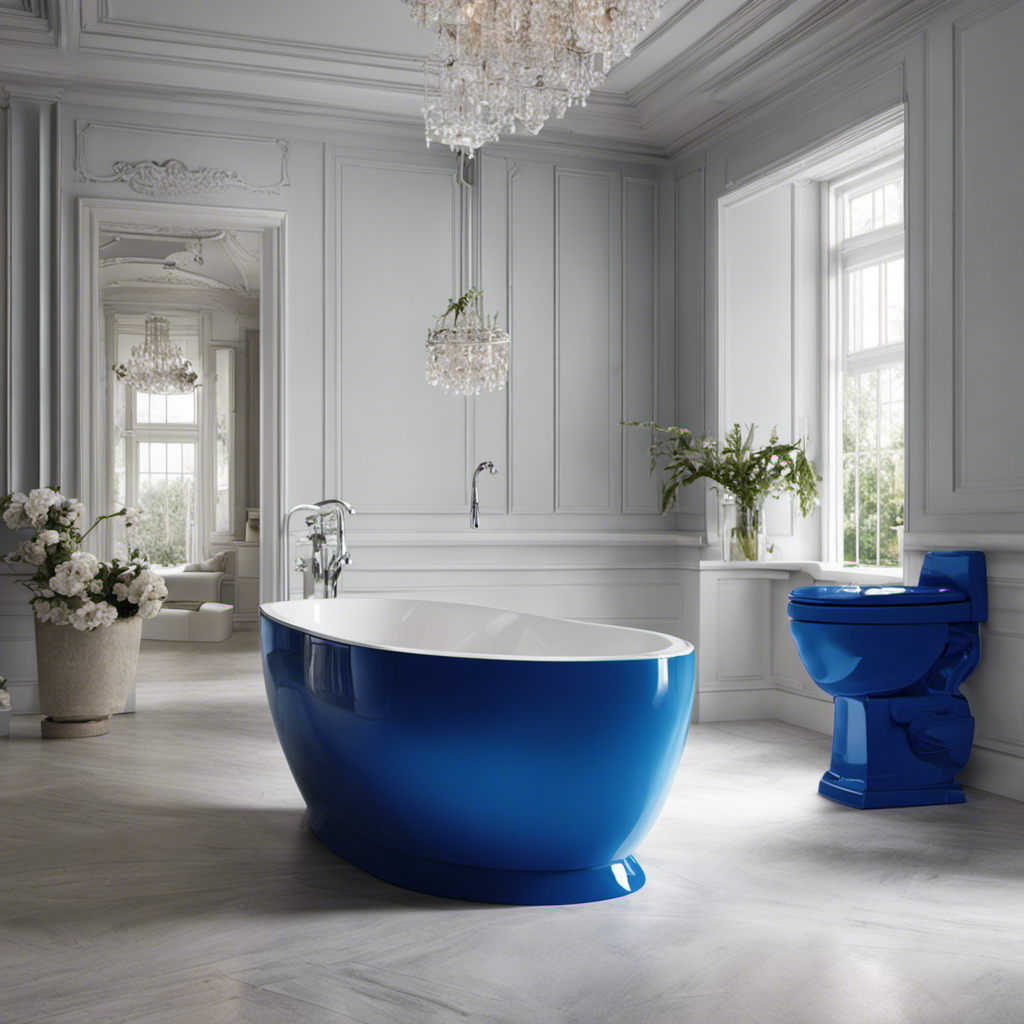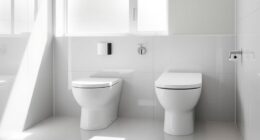Yes, you can install a toilet without a traditional floor drain by using an upflush system. These systems use a macerator pump to grind waste into slurry and push it through small pipes to the main sewer or septic line. This setup allows for more flexible bathroom placement and less extensive plumbing work. If you’re interested in exploring how upflush toilets work and their benefits, there’s more to discover ahead.
Key Takeaways
- Upflush systems enable toilet installation without a traditional floor drain by pumping waste through small pipes.
- They are ideal for bathrooms with limited space or existing plumbing constraints, eliminating the need for extensive underground piping.
- Proper setup requires assessing plumbing compatibility, space, and adherence to local building codes before installation.
- These systems can be noisy and may require regular maintenance, but offer a discreet, space-saving solution.
- Not all locations or plumbing configurations are suitable; consulting professionals ensures proper installation and compliance.
How Upflush Systems Work
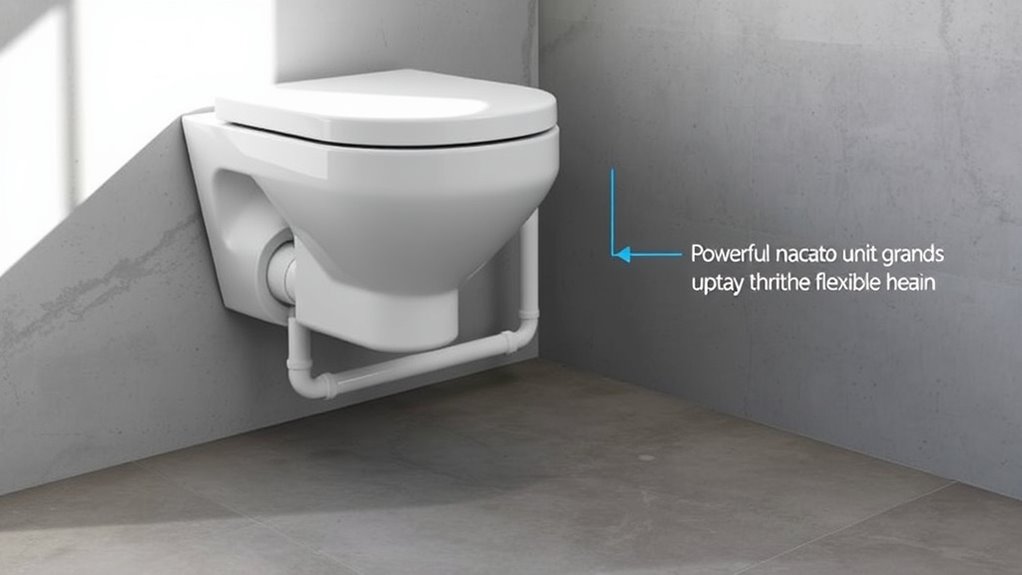
Upflush systems work by using a powerful macerator pump to grind waste from the toilet into a slurry. This process simplifies sewage management by breaking down solids quickly, allowing the waste to be pumped through small-diameter pipes to the main sewer line or septic system. Because these systems operate differently from traditional plumbing, they must comply with local plumbing regulations to guarantee safety and proper disposal. The pump activates automatically when the toilet is flushed, grinding waste and pushing it through the outlet pipe. This setup eliminates the need for floor drains or extensive underground piping, making it ideal for remodeling or installing bathrooms in unconventional spaces. Additionally, lifestyle considerations such as remote work flexibility can influence bathroom remodeling choices, especially when space constraints are involved. Proper installation and maintenance are essential to ensure the system functions efficiently and complies with all safety standards. Always check plumbing codes to verify your upflush system meets all required standards for safe and legal installation.
Benefits of Using Upflush Toilets
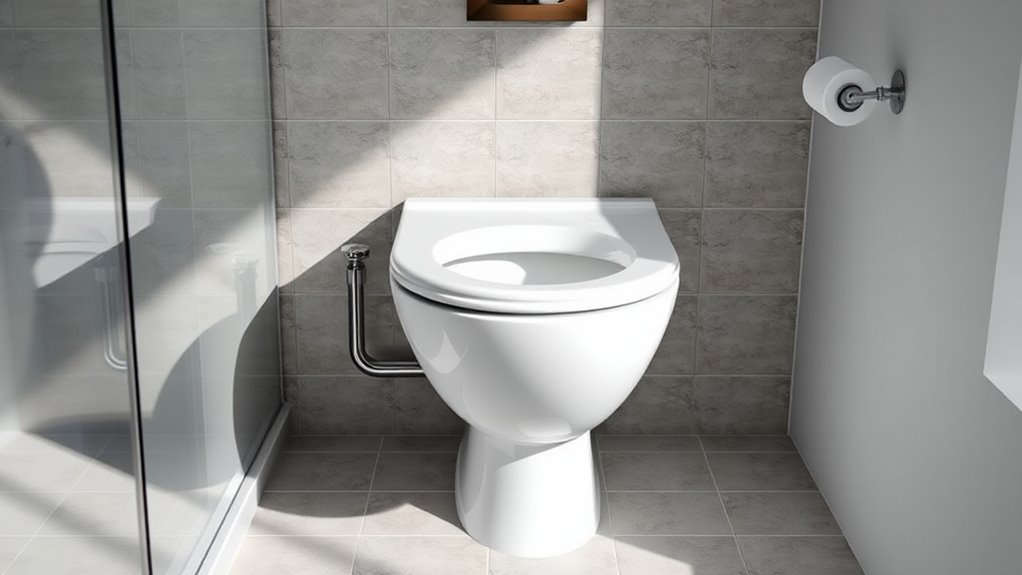
Choosing an upflush toilet offers several advantages that make it a practical choice for many homeowners. These systems are designed for water saving, helping you reduce water bills and conserve resources. They also maximize space efficiency, making them ideal for small or unconventional bathrooms. With upflush toilets, you can install a bathroom where traditional plumbing isn’t feasible, saving you from costly renovations. Plus, their compact design fits into tight spaces, giving you more flexibility in home layout. Here’s a quick overview of their benefits: Efficiency ratings can help you select models with optimal performance and savings.
| Feature | Benefit |
|---|---|
| Water Saving | Cuts down on water usage, lowering utility bills. |
| Space Efficiency | Frees up space, perfect for small or unusual areas. |
| Flexibility | Easy to install without extensive plumbing. |
Installation Process and Considerations
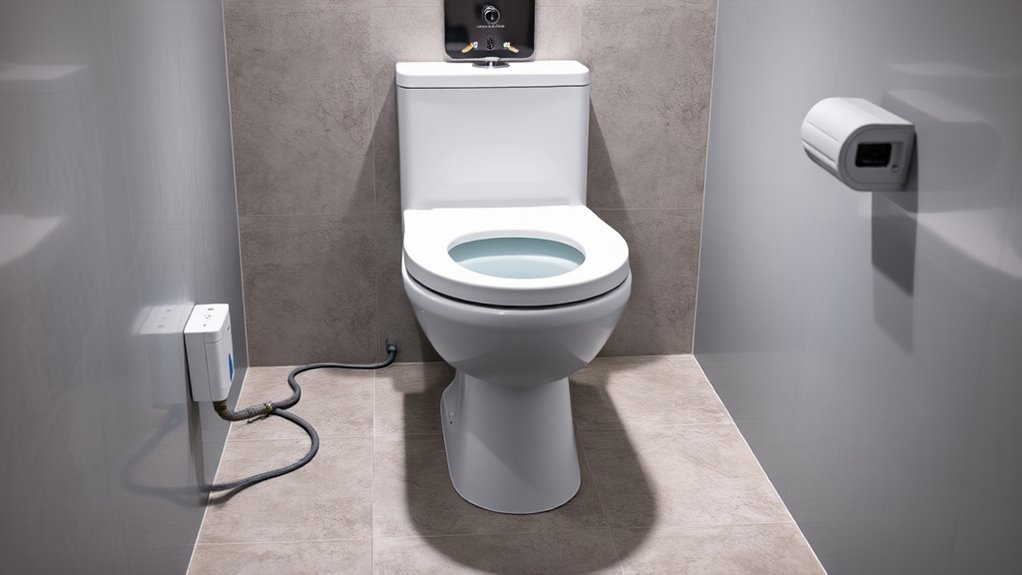
Installing a toilet without a floor drain involves careful planning to guarantee proper functionality and compliance with local codes. You need to assess plumbing compatibility, ensuring your existing pipes can connect to the upflush system. Consider the space available and the placement of the macerator pump, which influences overall performance. Be mindful of cost considerations, including the price of the upflush unit, installation, and potential modifications to your plumbing. Visualize:
- Connecting pipes running discreetly behind walls
- The compact size of the upflush system fitting into tight spaces
- Electrical wiring for the pump, hidden from view
- A clean, finished floor surface after installation
- Access points for maintenance, unobtrusively placed
Planning carefully guarantees your installation is seamless, functional, and compliant. Understanding self watering plant pots can help inform plumbing choices and layout considerations for tight or unconventional spaces. Additionally, verifying that your plumbing system aligns with the upflush technology ensures long-term reliability and avoids costly modifications later. It’s also important to consider the local building codes to ensure your setup meets all necessary regulations for safety and legality. Moreover, inspecting your home’s plumbing infrastructure beforehand can prevent unexpected issues during installation. Furthermore, consulting with a professional plumber can help address potential installation challenges and ensure optimal performance.
Limitations and Potential Challenges
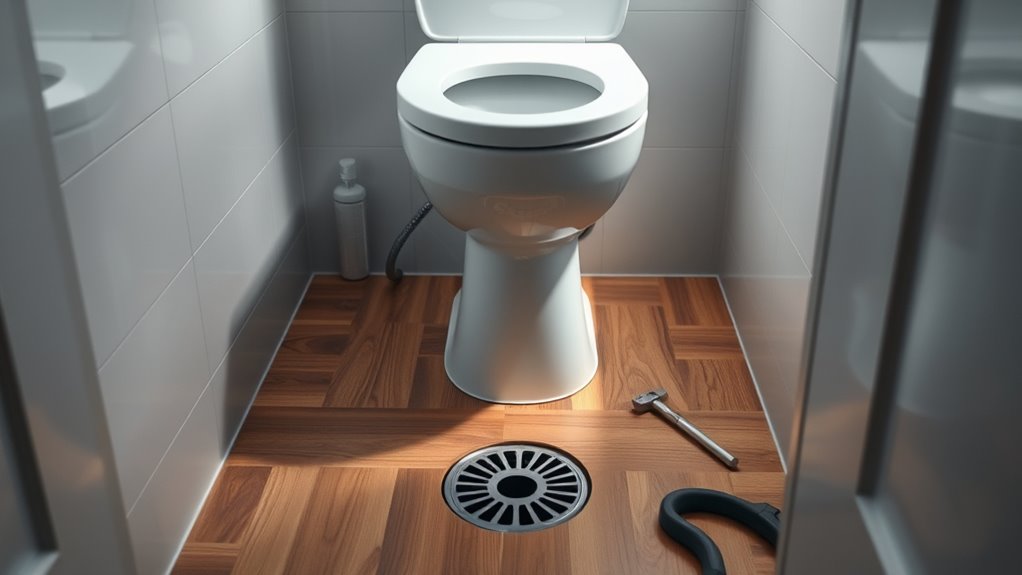
While installing a toilet without a floor drain offers flexibility, it also presents certain limitations and challenges that you should be aware of. Plumbing restrictions may limit your options, especially if existing pipes aren’t compatible with upflush systems. You might face difficulties connecting to the main drain or vent, which can increase installation complexity. Structural challenges also come into play; your floor or existing plumbing might need reinforcement to support the system’s components. Additionally, these systems can be noisy and may require regular maintenance to prevent clogging or malfunction. Keep in mind that some plumbing codes might restrict or complicate the installation of upflush systems in certain areas. Being aware of these limitations helps you plan accordingly and avoid surprises during installation. Understanding system compatibility is essential to ensure the chosen solution fits your current plumbing setup. Moreover, knowing how relationships influence plumbing choices can help anticipate potential issues with long-term use. Proper installation methods are crucial to minimize future problems and ensure the system operates effectively. It is also important to consider the long-term durability of the system, especially if it will be subjected to frequent use or specific environmental conditions. Consulting with a professional can help identify potential hidden obstacles that may not be immediately apparent.
Is an Upflush System Right for Your Bathroom?
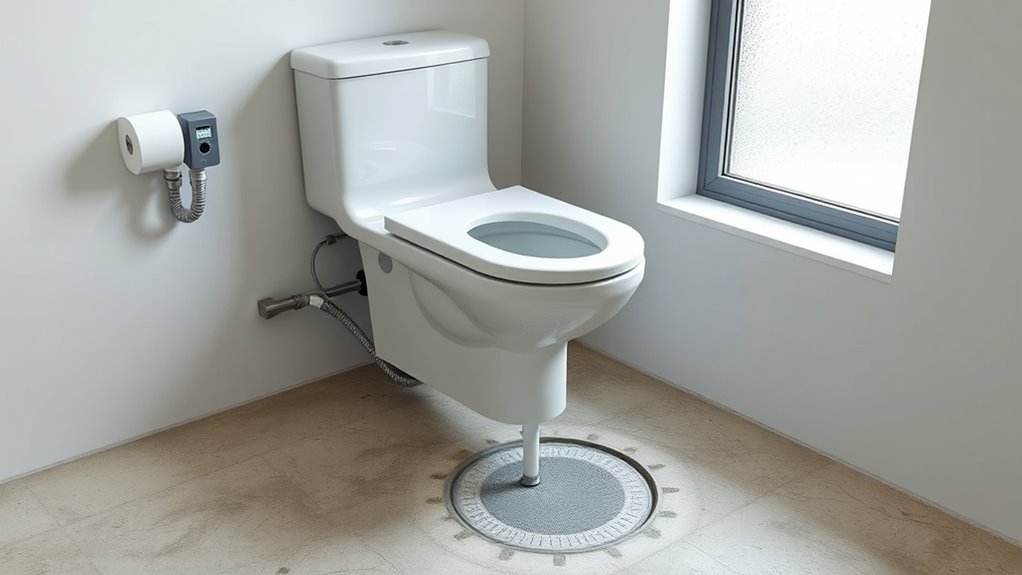
Deciding if an upflush system is suitable for your bathroom depends on your specific needs and circumstances. If you want to maintain bathroom aesthetics without extensive plumbing work, an upflush system can be a practical choice. However, you must also consider plumbing regulations, which vary by location and may restrict certain installations. Visualize your bathroom with:
- A sleek, modern toilet seamlessly integrated
- Minimal disruption to existing walls and floors
- A discreet, compact pump system tucked away
- Clean lines that enhance overall bathroom aesthetics
- Easy access for maintenance without major renovations
If these aspects align with your goals, an upflush system could be the right solution. Just ensure it complies with local plumbing regulations to avoid future issues. Additionally, considering sound vibrations in the system’s operation may improve user experience and reduce noise during use. Incorporating appropriate noise insulation can further enhance comfort and keep the bathroom environment quiet.
Frequently Asked Questions
How Long Do Upflush Systems Typically Last Before Maintenance Is Needed?
Upflush systems typically have an installation lifespan of 10 to 15 years, but this depends on usage and maintenance. You should expect to schedule maintenance every 1 to 3 years to keep it running smoothly. Regular inspections and prompt repairs help extend its lifespan, ensuring reliable performance. Proper maintenance frequency and care can allow your upflush system to serve you well for many years.
Can Upflush Toilets Be Installed in Outdoor or Exposed Environments?
You can install upflush toilets in outdoor or exposed environments, but you need to consider outdoor durability and guarantee proper protection against weather elements. These systems are designed to handle exposed installation, but you should use weather-resistant materials and secure the unit well. Proper insulation and drainage are essential to prevent freezing or damage. With careful setup, upflush toilets can function reliably in outdoor settings.
Are There Specific Plumbing Codes or Regulations for Upflush Systems?
Like a modern-day Icarus steering the sky, you must heed the rules of regulatory compliance and installation standards when working with upflush systems. These systems often have specific plumbing codes that ensure safe, proper operation. Before installation, check local building codes and manufacturer guidelines, as regulations vary. Staying compliant prevents issues down the line, ensuring your project is both legal and reliable, much like following a well-drawn map through uncharted territory.
How Noisy Are Upflush Systems During Operation?
You might wonder about the noise levels of upflush systems during operation. Generally, their operational sound is moderate, but some models can be noisier depending on the pump’s power and insulation. You’ll notice a humming or whirring sound while the system is running, but it usually isn’t disruptive. If quiet operation is important, choose an upflush system with soundproofing features, which help minimize the operational sound.
Can an Upflush Toilet Be Easily Relocated After Installation?
Relocating an upflush toilet is generally straightforward, thanks to its installation flexibility. You can often move it to a different spot without much hassle, as it doesn’t require traditional plumbing connections. With proper planning and some basic tools, the relocation ease makes upflush systems a practical option if you want flexibility in your bathroom layout. Just guarantee the new location has appropriate power and outlet access for smooth installation.
Conclusion
In the end, an upflush system is like a secret weapon for your bathroom renovation, turning the impossible into reality. It lets you install a toilet anywhere, even without a traditional floor drain, making your space more flexible. While it’s not perfect for every situation, if you’re willing to work around its quirks, you’ll find it a reliable solution. Think of it as a small miracle—bringing comfort and convenience right to your fingertips.

